2017-06-29 - Nº 113
Editorial
Esta é a Newsletter Nº 113 que se apresenta com o mesmo formato que as anteriores. Se gostar da Newsletter partilhe-a!
Todas as Newsletters encontram-se indexadas no link.
Esta Newsletter tem os seguintes tópicos:
Faz hoje anos que nascia, em 1903, Alan Blumlein. Este engenheiro electrotécnico inglês ficou conhecido pelas suas inúmeras invenções nos campos das telecomunicações, da gravação de som, do som estereofónico, da televisão e do radar. Blumlein patenteou o amplificador Ultra-Linear . Com um design aparentemente simples, o circuito forneceu uma ligação no enrolamento primário do transformador de saída para fornecer feedback para a segunda grelha, o que melhorou a linearidade do amplificador. Com a ligação colocada na extremidade do ânodo do enrolamento primário, o tubo (válvula) está efectivamente conectado como um triodo, e se a ligação estava na extremidade de alimentação, como um pentodo puro. Blumlein descobriu que, se a ligação fosse colocada a uma distância de 15-20% abaixo da extremidade de fornecimento do transformador de saída, o tubo ou a válvula combinariam as características positivas tanto do triodo quanto do design do pentodo. Faz também anos hoje que nascia George Ellery Hale. Nascido em Chicago em 1868 este astrónomo ficou conhecido pela sua descoberta de campos magnéticos em manchas solares e como elemento principal no planeamento e construção de vários telescópios de importância mundial; Nomeadamente, o telescópio de refracção de 40 polegadas no Yerkes Observatory, telescópio reflector Hale de 60 polegadas no Mount Wilson Observatory, telescópio reflector de 100 polegadas, no Mount Wilson, e o telescópio reflector Hale de 200 polegadas no Observatório Palomar. Por fim, faz hoje anos que nascia, em 1833, Peter Waage. Este químico Norueguês conjuntamente com seu cunhado Cato Maximilian Guldberg, descobriram e desenvolveram a lei de acção das massas entre 1864 e 1879.
Na semana que passou a Thyssenkrupp apresentou o primeiro elevador sem corda. O MULTI é uma das inovações mais avançadas do setor, desenvolvidas desde o século 19: o primeiro sistema de elevação sem corda e com movimento lateral do mundo. Em vez de uma cabine por eixo movendo-se para cima e para baixo, o MULTI oferece várias cabines operando em loop, como um sistema de metro dentro de um prédio. A Canonical passou a suportar o Ubuntu Core a correr no Raspberry Pi Compute Module 3. Ainda esta semana a fundação Eclipse apresentou o seu novo IDE - o Eclipse Oxygen. O Eclipse Oxygen deste ano é o 12º lançamento oficial simultâneo (SR); Inclui o trabalho árduo de 83 projectos de código aberto, que inclui aproximadamente duas milhões de novas linhas de código. O resultado deste processo é um repositório composto de software aberto e uma nova versão do Eclipse IDE. A versão Eclipse Oxygen inclui muitas melhorias na funcionalidade e desempenho, inclui novas ferramentas para análise de cobertura de código Java ™. Faz também hoje 10 anos que chegou às lojas o primeiro iPhone. Quer se goste ou não este produto marcou uma mudança no paradigma dos smartphone e impulsionou, fazendo algumas vitimas pelo caminho, uma verdadeira revolução na forma como usamos estes equipamentos no nosso dia-a-dia.
Na Newsletter desta semana apresentamos diversos projectos de maker assim como alguns modelos 3D que poderão ser úteis. Saiu a revista MagPI nº 59 e a revista newelectronics de 27 de Junho.
 João Alves ([email protected])
João Alves ([email protected])
O conteúdo da Newsletter encontra-se sob a licença  Creative Commons Attribution-NonCommercial-ShareAlike 4.0 International License.
Creative Commons Attribution-NonCommercial-ShareAlike 4.0 International License.
Novidades da Semana

The rope-less revolution begins now – first full-scale MULTI goes into operation
"The announcement of MULTI in 2014 was celebrated with a massively popular video. Since then, it has been the subject of widespread interest and recognition, most recently receiving Gold in the category of Transportation & Logistics at the 2017 Edison Awards. Now, MULTI is ready to go live. The medieval town of Rottweil, Germany, may seem an unusual place to test such futuristic technology, but in many ways it is the obvious choice. The new elevator-testing tower there is itself on the very cutting edge of applied science. It was also specifically designed to test MULTI – and on June 22nd, that is exactly what it will do. A full day of activities awaits the guests attending the unveiling of MULTI. The agenda includes presentations on every aspect of the MULTI, from a review of its maglev system, multi-level braking and inductive power technology, to a discussion of its interior design,an inspection of the testing shafts in the new towerand an exclusive on-site conference hosted by the Council on Tall Buildings and Urban Habitat. However, the main event addresses a central issue in the future of mobility. At the stroke of noon, MULTI rises – and the “rope-less revolution” begins. MULTI is the world’s first elevator system that altogether dispenses with cables or ropes. At first, that may sound like an odd thing to celebrate. But it is this ‘odd thing’ that opens up the possibility of an elevator that can go up, down, right, left – offering passengers a previously impossible opportunity to move about freely within buildings, and beyond. Make no mistake: this widely anticipated technology has the potential to revolutionize urban life, from underground subway construction to the design of buildings. And, as of June 22nd, 2017, the first fully functional unit is in use, in Rottweil, Germany." [...]
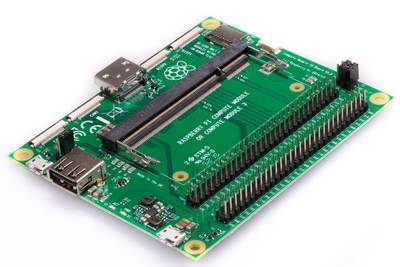
Canonical supports Ubuntu Core on the Raspberry Pi Compute Module 3
"Canonical, the company behind Ubuntu, today announces that its IoT OS, Ubuntu Core, is available on the Raspberry Pi Compute Module 3 – the general-purpose compute product from the Raspberry Pi Foundation. The Raspberry Pi Compute Module 3 (CM3), announced in January 2017, is a micro-version of the Raspberry Pi 3 intended to provide a simple, cost optimised single board computer. As the CM3 can be easily slotted in and out of any device with a standard, low-cost DDR2 SODIMM connector it provides an easy path for device creation, upgrading, or maintenance. Should your digital signage solution, for example, require new functionality or increased power after a period of use, upgrading its compute is now as simple as inserting a new board. The Compute Module 3 also has a more resilient storage built into the board making it a more robust compute option for industrial applications. Support for Ubuntu Core on the CM3 is another significant step towards Canonical’s vision of ‘Software Defined Everything’; a world where all devices can afford general purpose compute. By installing Ubuntu Core on the CM3, device manufacturers have an easy and cost-effective route to the production of fully-featured devices and can easily upgrade functionality through the addition of snaps – the universal Linux application packaging format. In addition, device manufacturers can develop their own app stores, all while benefiting from the additional security of Ubuntu Core." [...]

Eclipse Oxygen IDE Improvements: General, Java and Git
"Eclipse Oxygen has just been released! Thanks to all committers and contributors. Good job! The Eclipse Simultaneous Release is the end result of a process that sees the coordination of scheduling and communication across Eclipse Open Source Project teams. This year's Eclipse Oxygen is the 12th official simultaneous release; it includes the hard work from of 83 open source projects, comprising approximately two million net new lines of code.The output of this process is a composite repository of open source software, and a new release of the Eclipse IDE. The Eclipse Oxygen release includes many improvements in functionality and performance, includes new tools for Java™ code coverage analysis, and can be extended to support Java 9 development via an early access preview." [...]
Outras Notícias
- Watch SpaceX Rocket Re-Launch, Kicking Off Double Header
- Accelerating Deep Learning Research with the Tensor2Tensor Library
- FCC Approves Oneweb's Low-latency Internet Satellite NNetwork For Remote Areas
- Sony Makes "Core Libraries" of its Deep Learning Tools Available as Open Source
- New MCU software eliminates an FPGA to achieve a sub-1 microsecond current loop in industrial systems
- Toshiba Memory Corporation Announces 96-Layer 3D Flash Memory
- Next-Generation Bluetooth Low Energy Chip from STMicroelectronics Boosts the Boom of Connected Smart Things
- Qualcomm Snapdragon 450 Mobile Platform to Bring 14nm FinFET Process, Enhanced Dual-Camera Support and Fast LTE Connectivity to Mid-Range Smartphones and Tablets
- Samsung Introduces Image Sensor Brand ‘ISOCELL’ at 2017 MWC Shanghai
- NASA Completes Milestone Toward Quieter Supersonic X-Plane
- World’s largest automated port to become operational by year end
- Microsemi Announces General Availability of Engineering Samples for its Lowest Power, Cost-Optimized Mid-Range PolarFire FPGAs
- An Algorithm Helps Protect Mars Curiosity's Wheels
- AI’s big leap to tiny devices opens world of possibilities
- Happy Birthday: Apple's iPhone turns 10 years old
- AMD Ryzen PRO Desktop Processors Deliver Professional-Grade Performance, Security, and Reliability for Businesses Worldwide
Ciência e Tecnologia

A 100-year-old physics problem has been solved
"At EPFL, researchers challenge a fundamental law and discover that more electromagnetic energy can be stored in wave-guiding systems than previously thought. The discovery has implications in telecommunications. Working around the fundamental law, they conceived resonant and wave-guiding systems capable of storing energy over a prolonged period while keeping a broad bandwidth. Their trick was to create asymmetric resonant or wave-guiding systems using magnetic fields. The study, which has just been published in Science, was led by Kosmas Tsakmakidis, first at the University of Ottawa and then at EPFL's Bionanophotonic Systems Laboratory run by Hatice Altug, where the researcher is now doing post-doctoral research. This breakthrough could have a major impact on many fields in engineering and physics. The number of potential applications is close to infinite, with telecommunications, optical detection systems and broadband energy harvesting representing just a few examples." [...]
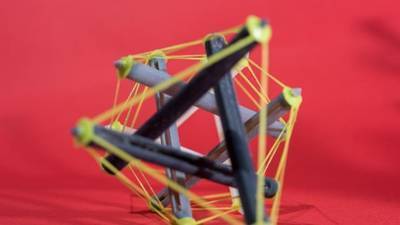
Researchers Create 3-D Printed Tensegrity Objects Capable of Dramatic Shape Change
"A team of researchers from the Georgia Institute of Technology has developed a way to use 3-D printers to create objects capable of expanding dramatically that could someday be used in applications ranging from space missions to biomedical devices. The new objects use tensegrity, a structural system of floating rods in compression and cables in continuous tension. The researchers fabricated the struts from shape memory polymers that unfold when heated. “Tensegrity structures are extremely lightweight while also being very strong,” said Glaucio Paulino, a professor in Georgia Tech’s School of Civil and Environmental Engineering. “That’s the reason there’s a heavy amount of interest right now in researching the use of tensegrity structures for outer space exploration. The goal is to find a way to deploy a large object that initially takes up little space.” The research, which was reported June 14 in the journal Scientific Reports, was sponsored by the National Science Foundation and the Air Force Office of Scientific Research. The researchers used 3-D printers to create the struts that make up one of the primary components of the tensegrity structure. To enable the struts to be temporarily folded flat, the researchers designed them to be hollow with a narrow opening that runs the length of the tube. Each strut has an attachment point on each end to connect to a network of elastic cables, which are also made with 3-D printers. Once the struts were heated to 65 degrees Celsius, the researchers could partially flatten and fold them into a shape resembling the letter W. The cooled structures then retain the temporary shape. With all cables attached, the objects can be reheated to initiate the transformation into tensegrity structures." [...]

Intelligent underground robot for urban environments is designed
"Participating in the project, which is coordinated by the UC3M Robotics Lab, are researchers from Germany, Greece, Italy and the United Kingdom. Its goal is to develop an intelligent system for the autonomous excavation of small diameter, high gradient tunnels in urban environments. “The use of innovative localization, mapping and navigation techniques, along with sensors and georadars, will allow them to be adapted to different land surfaces and aid in the analysis of the work environment and decision making in attaining the goals,” stated project coordinator, Carlos Balaguer, full professor in the UC3M Department of Systems Engineering and Automation. BADGER (roBot for Autonomous unDerGround trenchless opERations, mapping and navigation) is a project that incorporates several innovations. The main one is this new application of robotics to an underground environment. Until now, robotics was a field focused especially on walking or rolling surface robots and flying or underwater robots. Autonomous navigation, meanwhile, is another of the project’s strong points, as all the sensors, georadars and computers will be integrated in the machine, which enables them to make a much more precise and controlled exploration of the land. Lastly, the use of ultrasound techniques to perforate the ground, accompanied by a 3D printer on the robot itself to reinforce the tunnel where the cables and tubes lie, also plays an essential role." [...]
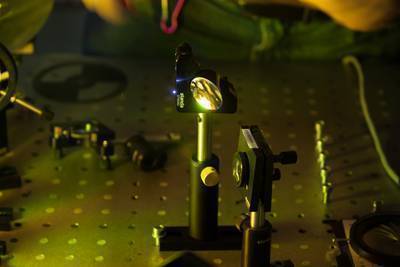
New Femto-Camera with Quadrillion Fractions of a Second Resolution
"Researchers from ITMO University have built a setup for recording holograms of tiny objects like living cells with a femtosecond speed. The new method allows one to reconstruct phase topography of a studied sample according to deformations that emerge in a laser pulse when it passes through the specimen. In comparison to electron microscopes, the device can visualize transparent biological structures without introducing contrast agents. The paper was published in Applied Physics Letters. Vital activity of living cells is a complex sequence of biochemical reactions and physical processes; many of them take place with high temporal resolution. To register such rapid transformations, scientists need very accurate and much faster equipment. Biological tissue can be studied with an electron microscope, but this method requires introducing a special dye in the sample. The dye makes cells contrast, although it may affect their metabolism. Digital holographic microscopes can cope with this drawback, but have low spatial resolution. The new camera created by ITMO scientists can register fast processes in transparent specimens and allows one to increase the resolution of images in a wide range. The device records phase deformations of ultrashort, or femtosecond, laser pulses, that emerge when the light passes through the studied sample. The phase images, or holograms, will help explore cells for better understanding mechanisms of autoimmune, oncological, neurodegenerative diseases, as well as monitoring cells during surgical interventions like, for example, cancer therapy." [...]

A Unique Data Centre For Cosmological Simulations
"Scientists from the Excellence Cluster Universe at the Ludwig-Maximilians-Universität Munich have establised "Cosmowebportal", a unique data centre for cosmological simulations located at the Leibniz Supercomputing Centre (LRZ) of the Bavarian Academy of Sciences. The complete results of a series of large hydrodynamical cosmological simulations are available, with data volumes typically exceeding several hundred terabytes. Scientists worldwide can interactively explore these complex simulations via a web interface and directly access the results. With current telescopes, scientists can observe our Universe’s galaxies and galaxy clusters and their distribution along an invisible cosmic web. From the exact measurement of the cosmic microwave background (CMB) with the Planck space observatory and many other measurements for example with the Hubble space telescope, the scientists were able to develop a precise model of our Universe. However, little is yet known about how these structures could form from the distribution of matter in the early universe. In order to answer this question, theoretical astrophysicists work with cosmological, hydrodynamical simulations. They test their hypotheses about the universe by developing mathematical models that describe the underlying complex physical processes and run them on high-performance computers trying to reproduce the evolution of the Universe over billions of years. If the underlying assumptions are correct, the simulations should match the current astronomical observations and findings. A group of astrophysicists led by Dr. Klaus Dolag from the Excellence Cluster Universe at the Ludwig-Maximilians-Universität Munich in close collaboration with the LRZ have now initiated "Cosmowebportal". This unique data centre for cosmological simulations provides access to the results of the world's most extensive set of cosmological hydrodynamic simulations, Magneticum Pathfinder, also developed by Klaus Dolag’s team and carried out at the LRZ. The complete simulations are saved at the LRZ in Garching on a data store for large datasets, which is connected to the supercomputer SuperMUC. Using a web interface, interested scientists can, for example, select objects from the raw simulation data, process it, and even create virtual observations mimicing existing or future space telescopes." [...]
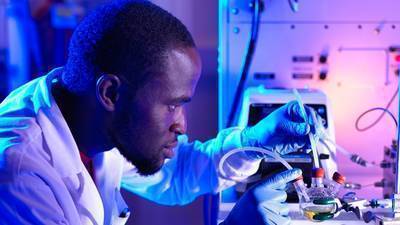
New Fast-Charging Flow Battery Aims to Advance the State-of-the-Art in Energy Storage
"Masdar Institute researchers have engineered a novel non-aqueous low-cost flow battery equipped with fast-charging that is able to charge itself in half the time it would normally take, which they believe may enable cheaper and more efficient large-scale renewable energy storage. The prototype battery has an open-circuit voltage of 1.2 volts, with an extra voltage of 1.8 volts leveraged for rapid charging. The device is the first such non-aqueous redox flow battery to employ the unique fast-charging design, cutting the amount of time it takes to fully charge by up to 50%. “Non-aqueous redox flow batteries have the potential to store more energy than aqueous-based systems, because organic solvents have a wider voltage window than that of water; which allows for formulation of battery chemistries with higher open-circuit voltages. But due to other challenges, their performance has not yet reached the levels achieved by their water-based counterparts,” explained Musbaudeen Bamgbopa, a PhD student at MI. He believes that a major opportunity for non-aqueous flow batteries – which are a type of flow battery that utilize solvents other than water – is for scientists to expand their focus on performance improvement beyond a narrow focus on increasing energy density. Bamgbopa and his advisor, Dr. Saif Almheiri, Assistant Professor of Mechanical and Materials Engineering, realized that there was another way to capitalize on the wide voltage window of non-aqueous flow batteries. “What we did in our work is present another advantage of the non-aqueous based redox flow system that scientists have overlooked. Instead of trying to increase our battery’s energy density, we used that extra allowable voltage for fast-charging,” Dr. Almheiri shared. The MI researchers published their results in a paper earlier this month in the Journal of Materials Chemistry A." [...]

Computer system predicts products of chemical reactions
"When organic chemists identify a useful chemical compound — a new drug, for instance — it’s up to chemical engineers to determine how to mass-produce it. There could be 100 different sequences of reactions that yield the same end product. But some of them use cheaper reagents and lower temperatures than others, and perhaps most importantly, some are much easier to run continuously, with technicians occasionally topping up reagents in different reaction chambers. Historically, determining the most efficient and cost-effective way to produce a given molecule has been as much art as science. But MIT researchers are trying to put this process on a more secure empirical footing, with a computer system that’s trained on thousands of examples of experimental reactions and that learns to predict what a reaction’s major products will be. The researchers’ work appears in the American Chemical Society’s journal Central Science. Like all machine-learning systems, theirs presents its results in terms of probabilities. In tests, the system was able to predict a reaction’s major product 72 percent of the time; 87 percent of the time, it ranked the major product among its three most likely results." [...]
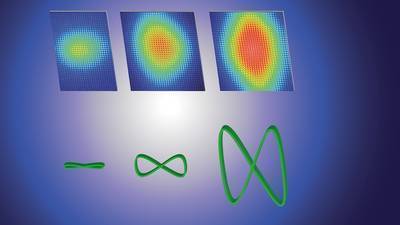
1 billion suns: World’s brightest laser sparks new behavior in light
"By focusing laser light to a brightness 1 billion times greater than the surface of the sun — the brightest light ever produced on Earth — the physicists have observed changes in a vision-enabling interaction between light and matter. Those changes yielded unique X-ray pulses with the potential to generate extremely high-resolution imagery useful for medical, engineering, scientific and security purposes. The team’s findings, detailed June 26 in the journal Nature Photonics, should also help inform future experiments involving high-intensity lasers. Donald Umstadter and colleagues at the university’s Extreme Light Laboratory fired their Diocles Laser at helium-suspended electrons to measure how the laser’s photons — considered both particles and waves of light — scattered from a single electron after striking it. Under typical conditions, as when light from a bulb or the sun strikes a surface, that scattering phenomenon makes vision possible. But an electron — the negatively charged particle present in matter-forming atoms — normally scatters just one photon of light at a time. And the average electron rarely enjoys even that privilege, Umstadter said, getting struck only once every four months or so. Though previous laser-based experiments had scattered a few photons from the same electron, Umstadter’s team managed to scatter nearly 1,000 photons at a time. At the ultra-high intensities produced by the laser, both the photons and electron behaved much differently than usual." [...]
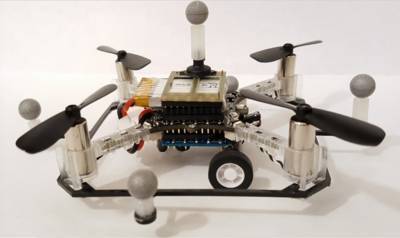
Drones that drive
"Being able to both walk and take flight is typical in nature — many birds, insects, and other animals can do both. If we could program robots with similar versatility, it would open up many possibilities: Imagine machines that could fly into construction areas or disaster zones that aren’t near roads and then squeeze through tight spaces on the ground to transport objects or rescue people. The problem is that robots that are good at one mode of transportation are usually bad at another. Airborne drones are fast and agile, but generally have too limited of a battery life to travel for long distances. Ground vehicles, on the other hand, are more energy efficient, but slower and less mobile. Researchers from MIT’s Computer Science and Artificial Intelligence Laboratory (CSAIL) are aiming to develop robots that can both maneuver around on land and take to the skies. In a new paper, the team presented a system of eight quadcopter drones that can fly and drive through a city-like setting with parking spots, no-fly zones, and landing pads." [...]
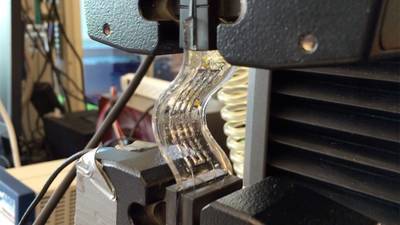
New Design Improves Performance of Flexible Wearable Electronics
"In a proof-of-concept study, North Carolina State University engineers have designed a flexible thermoelectric energy harvester that has the potential to rival the effectiveness of existing power wearable electronic devices using body heat as the only source of energy. Wearable devices used to monitor a variety of health and environmental measures are becoming increasingly popular. The performance and efficiency of flexible devices, however, pale in comparison to rigid devices, which have been superior in their ability to convert body heat into usable energy." [...]

Ahead of the Curve
"3D printers have been around since the 1980s, but we are still far from maximizing their potential. One active area of research and development is “self-actuating” objects: flat materials that transform themselves through material forces into the desired 3D object. Previously, however, the range of objects was limited to those with sharp edges and little, if any, curvature, and the transformation methods were based primarily on folding or processes that could not be controlled very precisely (e.g. chemical reactions or inflation). Now, for the first time, a group of current and former IST Austria computer scientists have made it possible to create self-actuating, smooth, free-form objects. In so doing, they developed both an ingenious material design and a new method of self-transformation—they call the fruits of their innovation “CurveUps”. Moreover, the team, which consists of Ruslan Guseinov, Eder Miguel, and Bernd Bickel, developed the computational tools to take a user-provided 3D model and automatically create a 2D flattened template that, upon release, transforms into the original 3D version. The goal of the project was ambitious in a number of ways. First, it is very challenging to obtain a final 3D object that is mechanically stable. Moreover, the team had to develop a controllable mechanism to accomplish this. “I experimented with so many different materials and methods before coming up with our current design,” says first author Ruslan Guseinov. CurveUps are made up of tiny tiles sandwiched between pre-stretched latex layers. During the transformation process, the tension in the latex pulls the tiles together joining them into a continuous shell. An innovative design and transformation method were only part of the team’s contribution, however. With these ideas in hand, the team focused on developing tools to create the 2D templates for printing. In particular, their program takes a user-supplied 3D form, and automatically generates a 2D tile layout, including the orientation, location and shape of each tile and connecting pins. However, as even small models will have hundreds or thousands of individual tiles, this represents an optimization problem of tremendous proportions—infeasible, on any personal computer. To get around this, the group implemented a two-step optimization procedure, which first gives an approximate solution, then performs local refinements before producing a final template. The entire procedure, from 3D model to a CurveUp, can be viewed online here. CurveUps are not just technically and mathematically impressive, they represent an important breakthrough in terms of 3D printing. “Our research is a step toward the development of new fabrication technologies: there have been many advances in flat fabrication, for instance in electronics, that have previously been limited to 2D shapes,” Ruslan Guseinov explains. “With CurveUps, we make it possible to produce 3D objects empowered with these same technologies, pushing the limits of digital manufacturing far beyond the current state.”" [...]
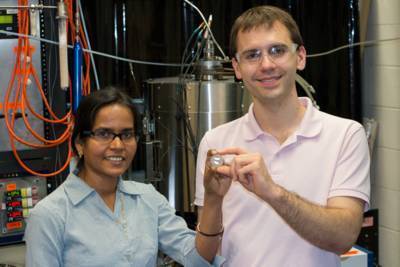
A new way of extracting copper
"MIT researchers have identified the proper temperature and chemical mixture to selectively separate pure copper and other metallic trace elements from sulfur-based minerals using molten electrolysis. This one-step, environmentally friendly process simplifies metal production and eliminates the toxic byproducts such as sulfur dioxide. Postdoc Sulata K. Sahu and PhD student Brian J. Chmielowiec ’12 decomposed sulfur-rich minerals into pure sulfur and extracted three different metals at very high purity: copper, molybdenum, and rhenium. They also quantified the amount of energy needed to run the extraction process. An electrolysis cell is a closed circuit, like a battery, but instead of producing electrical energy, it consumes electrical energy to break apart compounds into their elements, for example, splitting water into hydrogen and oxygen. Such electrolytic processes are the primary method of aluminum production and are used as the final step to remove impurities in copper production. Contrary to aluminum, however, there are no direct electrolytic decomposition processes for copper-containing sulfide minerals to produce liquid copper. The MIT researchers found a promising method of forming liquid copper metal and sulfur gas in their cell from an electrolyte composed of barium sulfide, lanthanum sulfide, and copper sulfide, which yields greater than 99.9 percent pure copper. This purity is equivalent to the best current copper production methods. Their results are published in an Electrochimica Acta paper with senior author Antoine Allanore, assistant professor of metallurgy." [...]
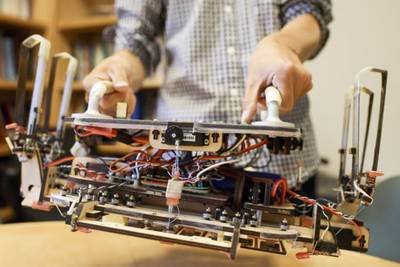
Stanford engineers design a robotic gripper for cleaning up space debris
"Right now, about 500,000 pieces of human-made debris are whizzing around space, orbiting our planet at speeds up to 17,500 miles per hour. This debris poses a threat to satellites, space vehicles and astronauts aboard those vehicles. What makes tidying up especially challenging is that the debris exists in space. Suction cups don’t work in a vacuum. Traditional sticky substances, like tape, are largely useless because the chemicals they rely on can’t withstand the extreme temperature swings. Magnets only work on objects that are magnetic. Most proposed solutions, including debris harpoons, either require or cause forceful interaction with the debris, which could push those objects in unintended, unpredictable directions. To tackle the mess, researchers from Stanford University and NASA’s Jet Propulsion Laboratory (JPL) have designed a new kind of robotic gripper to grab and dispose of the debris, featured in the June 27 issue of Science Robotics." [...]
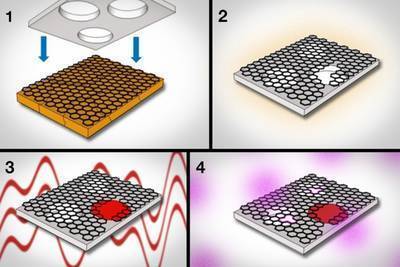
Scientists produce dialysis membrane made from graphene
"Dialysis, in the most general sense, is the process by which molecules filter out of one solution, by diffusing through a membrane, into a more dilute solution. Outside of hemodialysis, which removes waste from blood, scientists use dialysis to purify drugs, remove residue from chemical solutions, and isolate molecules for medical diagnosis, typically by allowing the materials to pass through a porous membrane. Today’s commercial dialysis membranes separate molecules slowly, in part due to their makeup: They are relatively thick, and the pores that tunnel through such dense membranes do so in winding paths, making it difficult for target molecules to quickly pass through. Now MIT engineers have fabricated a functional dialysis membrane from a sheet of graphene — a single layer of carbon atoms, linked end to end in hexagonal configuration like that of chicken wire. The graphene membrane, about the size of a fingernail, is less than 1 nanometer thick. (The thinnest existing memranes are about 20 nanometers thick.) The team’s membrane is able to filter out nanometer-sized molecules from aqueous solutions up to 10 times faster than state-of-the-art membranes, with the graphene itself being up to 100 times faster. While graphene has largely been explored for applications in electronics, Piran Kidambi, a postdoc in MIT’s Department of Mechanical Engineering, says the team’s findings demonstrate that graphene may improve membrane technology, particularly for lab-scale separation processes and potentially for hemodialysis." [...]
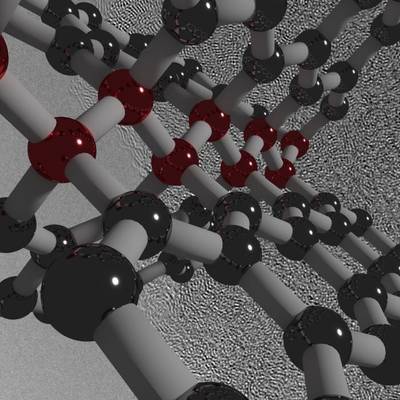
New form of carbon that’s hard as a rock, yet elastic, like rubber
"A team including several Carnegie scientists has developed a form of ultrastrong, lightweight carbon that is also elastic and electrically conductive. A material with such a unique combination of properties could serve a wide variety of applications from aerospace engineering to military armor. Carbon is an element of seemingly infinite possibilities. This is because the configuration of its electrons allows for numerous self-bonding combinations that give rise to a range of materials with varying properties. For example, transparent, superhard diamonds, and opaque graphite, which is used for both pencils and industrial lubricant, are comprised solely of carbon. In this international collaboration between Yanshan University and Carnegie—which included Carnegie’s Zhisheng Zhao, Timothy Strobel, Yoshio Kono, Jinfu Shu, Ho-kwang “Dave” Mao, Yingwei Fei, and Guoyin Shen— scientists pressurized and heated a structurally disordered form of carbon called glassy carbon. The glassy carbon starting material was brought to about 250,000 times normal atmospheric pressure and heated to approximately 1,800 degrees Fahrenheit to create the new strong and elastic carbon. Their findings are published by Science Advances. Scientists had previously tried subjecting glassy carbon to high pressures at both room temperature (referred to as cold compression) and extremely high temperatures. But the so-called cold-synthesized material could not maintain its structure when brought back to ambient pressure, and under the extremely hot conditions, nanocrystalline diamonds were formed. The newly created carbon is comprised of both graphite-like and diamond-like bonding motifs, which gives rise to the unique combination of properties. Under the high-pressure synthesis conditions, disordered layers within the glassy carbon buckle, merge, and connect in various ways. This process creates an overall structure that lacks a long-range spatial order, but has a short-range spatial organization on the nanometer scale." [...]
Modelos 3D
Com a disponibilidade de ferramentas que permitem dar azo a nossa imaginação na criação de peças 3D e espaços como o thingiverse para as publicar, esta rubrica apresenta alguns modelos selecionados que poderão ser úteis.
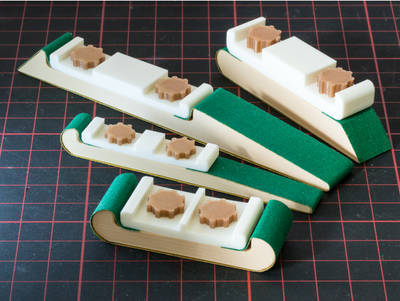
Customizable Sanding Stick
"I like the idea of the Sanding stick by workshopbob, but I don't want to buy some hex screws. So I've created this thing, where you can customize your sanding stick, that will automatically include the needed printable screws." [...]
Documentação
A documentação é parte essencial do processo de aprendizagem e a Internet além de artigos interessantes de explorar também tem alguma documentação em formato PDF interessante de ler. Todos os links aqui apresentados são para conteúdo disponibilizado livremente pelo editor do livro.

The MagPI 59
"Can you really use a Raspberry Pi 3 as a desktop replacement? That’s the question we asked The MagPi maestro Rob Zwetsloot, as we tasked him to use a Raspberry Pi, and only a Raspberry Pi, as his sole computer for a week. You can read all about it in issue 59 of The MagPi – The Official Raspberry Pi magazine, out in stores today! The desktop computer is a dying breed these days, especially in the home. What better replacement for the old desktop PC than a Raspberry Pi, the ultimate low-cost but high-power computer. We’ve claimed several times that you can use a Raspberry Pi as your main computer, but this time we did it scientifically. By asking Rob to use a Raspberry Pi as his main computer for a week. For science! Summer is upon us (both rain and shine in the UK). The Raspberry Pi is small and portable, and lends itself to great outdoor projects. So we’ve gathered 12 of the best projects for outdoor use. From weather monitors to hot air balloons, there’s something here for all intrepid Raspberry Pi users. There’s a lot going on in The MagPi 59. From amazing projects like the Dog Treat Dispenser to Big Rob, the robot that uses SatNav for incredible precision. We’ve also got a guide to using the Sense HAT emulator, creating an Android app to control a Pi with Bluetooth, how to build a GPS tracking device and electronic wind chimes." [...]
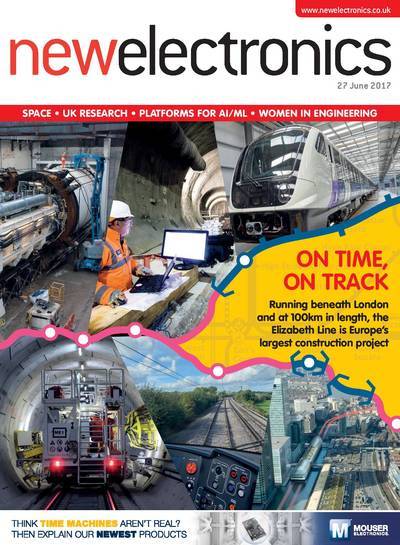
newelectronics 27 Junho 2017
"New Electronics is a fortnightly magazine focusing on technological innovation, news and the latest developments in the electronics sector. Downloadable as a digital page turner or pdf file, or offered as a hard copy, the New Electronics magazine is available in a format to suit you." [...]
Projetos Maker
Diversos Projetos interessantes.

DIY ultra cheap combination lock
"Today I am back with another project called DIY ULTRA CHEAP COMBINATION LOCK CIRCUIT. A combination lock is a type of locking device in which a sequence of numbers or symbols is used to open the lock. There are two types of combination lock available, Analog and digital. In analog type the sequence may be entered using a single rotating dial which interacts with several discs or cams, by using a set of several rotating discs with inscribed numerals which directly interact with the locking mechanism. On other hand digital locks are using keypads to enter the code. Now we are going to make a digital combination lock circuit using simple components. yes I know I can use an AUDINO. But my goal is different" [...]
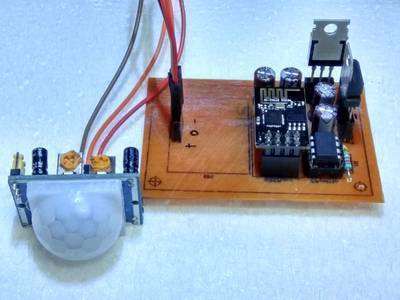
Tiny Security Using ATtiny85
"Today we are gonna make a "Tiny Security" using Atmel ATtiny85. Our final system will consists of ATtiny85, ESP8266-01, PIR sensor, Other electronic components(capacitors,resistors,voltage regulators,battery). How does this "Tiny Security" works? The PIR sensor in the system detects human in its surrounding and sends data to ATtiny. ATtiny85 commands ESP8266-01 to send data to cloud through internet. From cloud we get sms alert to our mobile and also we get sound alert via webpage from browser." [...]

Arduino Tamagotchi Clone - Digital Pet
"With over 76million units sold worldwide Tamagotchi was one of the most popular toys of the 90s. As you can see on the small OLED display we take care of a small dinosaur. Using the meters, like the hunger meter, the happy or the discipline meter we can determine how healthy and well behaved the dinosaur is. We can feed the dinosaur, play with it, visit the doctor when it gets sick and many more things. As you can see, the game offers great features and animations. It is a very addictive toy, I remember playing with a Tamagotchi for months when I was a kid. I still remember the day that my first Tamagotchi died. This project brings back so many memories from my childhood and that’s why I decided to build one. This project is developed by Alojz, a friend from Serbia. He has done an amazing job. I discovered his work a few months ago. He has built a website where he shares everything about this project. The code, the schematic diagram, even a 3D printed enclosure for it. He has done a fantastic job in this project. Even if you are not interested in building the project, study the code. Alojz is a very skilled developer so you are going to learn a lot from his code." [...]
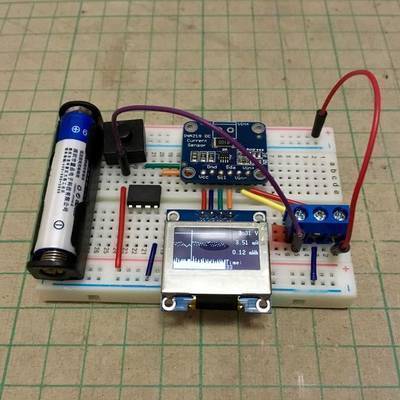
ATtinyPowerMeter
"This instructables show how to make a simple power meter using 3 components: ATtiny85, INA219 and OLED module. It can continuous measure the voltage(V), current(mA) and accumulated power usage(mWh). And also plot a simple graph to visualise the figures." [...]
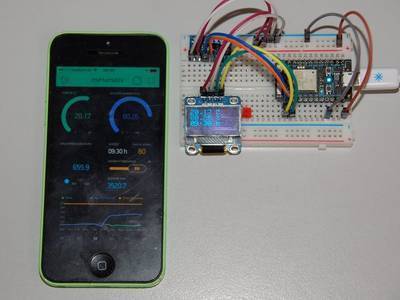
MyHumidity Controlled by BME280 and Photon
"This week, a friend of mine occupied me quite a bit: it was about his rental apartment, in which he had for some time discovered moisture above the windows. Here the danger of mold formation lurks. Currently, he is diligently renovating and argues with his landlord about the cost. He had set up customary humidity sensors, which showed him the current value. He did not have a data series for several weeks. As far as the initial situation. A Particel Photon was quick to hand and sparked in my own network. But how should I get my small project for moisture measurement and reporting into its WiFi? How could I prepare it so far that he can access my equipment as comfortably as possible?" [...]

Basic IC Tester Using Arduino NANO
"Basically this is the easiest project with Arduino Nano but more of thinking in the code. This project involved with circuit design and coding. This is done by 2 layer PCB and Arduino Nano, which test the basic IC's like gates. This project is made to test only two IC's ( 7408 and 7432 ), But we can increase this design to 8 IC's based on the type of IC and compatibility with Arduino Nano pins. This project Does : Testing the IC placed with per-defined Op-Code and resulting with LED's. If Green LED glows then the IC is good, If Red LED glows then the IC is not good. Indicating these two results we can test the given IC." [...]
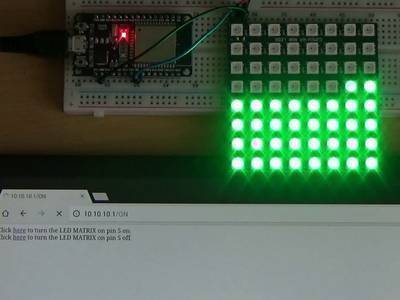
ESP and WS2812 8x8 LED Matrix
"I have been playing with ESP32 and WB2812 LED 8x8 matrix. In video you will see flickering which is due Adafruit_NeoPixel library written for Arduino, not for ESP32. But as proof of concept it works." [...]
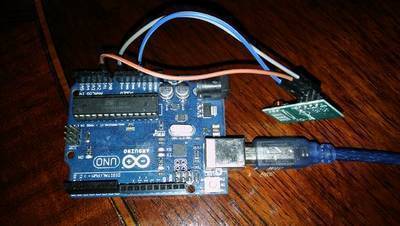
Radio Frequency Cloning
"This is the third chapter of a big series of domotics experiments. In this case we will be using an Arduino and RF receiver to clone the signal emitted by a remote control. In my case, I had a series of lights that I turn on and off using this remote control. The idea is to clone the signals to be able to send them through a RF emitter and activate the sending from every where. For example a computer. So lets get started." [...]
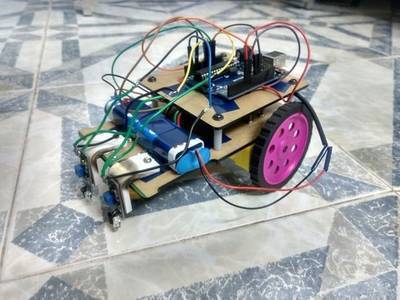
Arduino Based Line Following Robot
"The following Instructible deals with making a simple line following robot using arduino uno. Please note that I am a beginner. This is my first time working with arduino. I welcome all criticism, comments and advice. :) This project, I believe can give you a good intro into using arduino micro controller. For a pro, I do not think it will take more than 2 hours, but for a noob like me, it can take a week, learning each aspects one by one." [...]

DIY AWESOME MP3 Player
"I love to listen music and I am sure everyone in the world loves to hear music in their leisure time or when they need to relax. Of Course, There are numerous devices on which you can play music , may it be your smartphone or a tablet or maybe a PC and also some may be using old mp3 player. But needless to say smartphones can be bulky sometimes if you just want to play downloaded songs while running or working. As a maker I wanted have a small and full featured mp3 player capable of playing music for around 10 -12 hours as i always forget to charge the battery. Also It should be small enough so that it should not jiggle and wobble while i am running or working. Without wasting any time lets get started." [...]
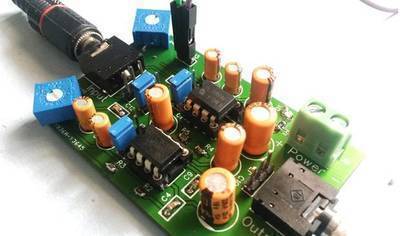
Audio Amplifier Circuit on PCB Using LM386
"In this project, we tend to area unit getting to create a Headphone/Audio electronic equipment by exploitation self-designed PCB. This project is especially designed for amplifying the audio signal from the headphones however we will additionally use it for amplifying the subwoofer or speaker output, simply by switch few jumpers. When we use headphones with our audio device like mobile, laptop, FM etc. The facility is adequate for traditional user however not adequate for loud music listeners or generally we tend to get terribly low sound from some devices. Thus to deal with this problems, we've got created this handy hobby gadgets specifically phone electronic equipment. This circuit can even be used as amplifier to amplify the Subwoofer output and might be steam-powered by a transportable battery, therefore the user will carry it anyplace and it. Check the entire details below." [...]
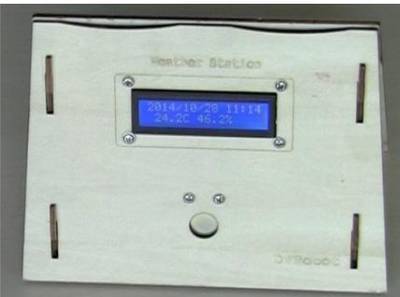
How to Make a DIY Weather Station
"The fast pace of modern life greatens the distance between human and nature, making more kids caged in the concrete jungle. However, interacting with nature is an indispensable part in their growth. Weather itself, can be an accessible yet interesting subject for kids to study. Through meteorological observations, recording and analyzing, kids can literally learn and do science that is combined seamlessly with their daily life activities. From terraces to living rooms, in backyards and in classrooms, this DIY Weather Station Kit can be used in measuring both indoor and outdoor data concerning temperature, humidity and barometric pressure. It comes with a solar panel, which provides auxiliary power supply to the system. This DIY Weather Station Kit is both energy-saving and green, and can help to develop kids's interest in natural science." [...]
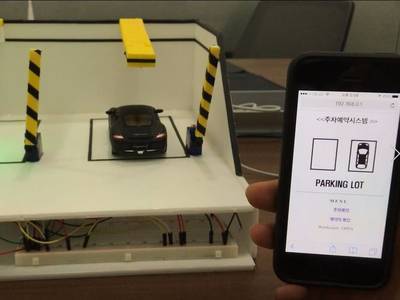
Parking Lot IoT System
"We made a parking lot IoT system. We can check for vacancies through the webpage and reserve a parking space. When we reserve a parking space, the parking space is blocked. Blocked parking spaces are released through confirmation of the reservation. It will help people reduce the amount of time spent parking." [...]
Wifi controlled ceiling fan
"When Amazon announced the Echo Dot 2.0 at $50, I was ready to give Alexa a try. Since my young children were not tall enough to pull the chains on their ceiling fan, I typically ended up having to turn on or off their light or fan for them. After some research, I found https://github.com/arendst/Sonoff-MQTT-OTA-Arduino, which could turn an inexpensive https://www.itead.cc/sonoff-dual.html into a pair of Alexa controllable relays (one for the light, the other for the fan). I wanted to make sure the sonoff worked before hacking it. I installed the default EWeLink app on my phone and iPad. Unfortunately, it does require you to sign up. I then cutt a two conductor indoor extension cord in half, and connecting the sonoff in the middle. Then plugging in a desk lamp to it. Extension cords vary by country/region. In the United States, we have polarized plugs. The narrow lead is 'hot', and the wider lead is 'neutral'. I would recommend following that when connecting the sonoff. I have a digital multimeter that checks continuity. " [...]
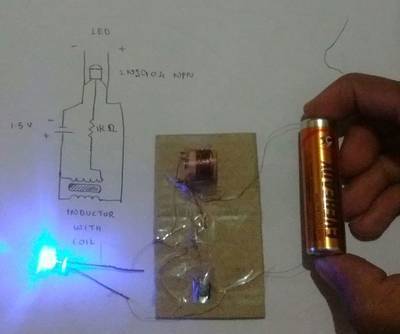
Efficient Joule Thief Power Supply
"Hey everyone, getting busy with your DIY projects? If your projects are LED based, you will require a power supply that is quite efficient and make sure the circuit consumes low power. A joule thief can be a solution. Only problem, its quite hard to build, especially for beginners. No worries! In this instructable, I shall teach you how to build an easy and powerful joule thief." [...]

Multi Channel Analyzer for Gamma Spectroscopy With Arduino & Theremino
"I'd like to show you my homemade multi-channel-analyzer for gamma spectroscopy using a.) the freeware theremino and b.) an arduino. First of all I have to say some words about gamma spectroscopy at all. To detect radioactive decays you need a detector like a geiger-Counter. For gamma-spectroscopy you have to take a photomultiplier combined with a scintillation crystal made of sodium Iodide. You can get both things on ebay for less than 100 USD. The gamma-rays from the radioactive source is going through the scintillation crystal and produce very faint light-flashes. Those light-flashes are recorded by the photomultiplier, who converts them is small voltage-pulses at the Output. For this the photomultiplier and the Crystal have to be in a absolutely light-tight housing. I use shrinkable tubing for that. The Job of the multi-channel-analyzer (MCA) is to measure the height of those pulses coming from the photomultiplier. This is because every gamma-photon produces a voltage-pulse with a height depending on it's energy. The higher the energy of the gamma-photon, the higher the voltage pulse. When the pulse-height has been measured, the number pulses with this recorded amplitude can be increased by one. At the end you get a spectrum of number of pulses versus pulse-height, which is characteristic for each radioactive element. For example cesium-137 emits gama-rays with an energy of 662 keV. They will produce pulses with a certain pulse-height. With a MCA you'll get a spectrum with a peak at a certain voltage corresponding to the pulse-height. Therefore you can identify radioactive sources with a MCA. You don't get just the so called photo-peak, but also characteristic structures like the compton-edge, which is produced by the scattered electrons." [...]
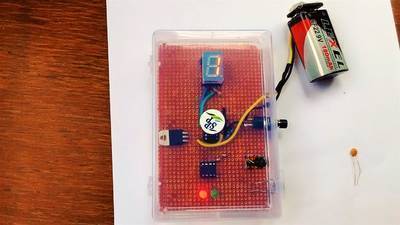
The Attiny85/45 Capacitor Tester
"Many multi meters (like mine) don't have the functionality of measuring capacitance. This is especially annoying as one has no way of determining how accurate a capacitor is. If you doubt your resistor you can easily measure it, but not so for the capacitor (if you have a multi meter like mine). So in this instructable I'm going to show you how to create a capacitance meter using an Attiny 85/45. This tester also has a 7 segment display to show the value." [...]
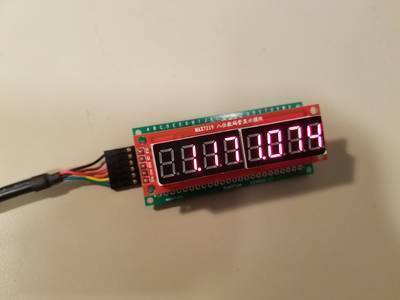
YouTube Channel IoT View Counter
"I've wanted an Internet connected read-out for some time now, inspired by the awesome shadow box IoT projects Becky Stern has been doing (weather, YouTube subscribers). I'm certainly not to the same level of packaging as her yet, but I've got a functional display working with a Hazzah and an eBay seven segment display module." [...]
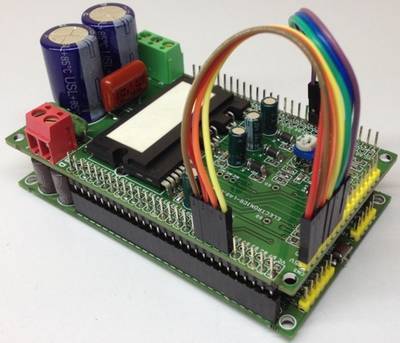
Inteligent Power Module (IPM) Board for Brushless Motors
"Intelligent Power Module (IPM) board has been designed using FSBS5CH60 IC from Fairchild, which provides a fully-featured, high-performance inverter output stage for AC Induction, BLDC, and PMSM motors. These modules integrate optimized gate drive of the built-in IGBTs to minimize EMI and losses, while also providing multiple on-module protection features including under-voltage lockouts, over-current shutdown, and fault reporting. The built-in, high-speed HVIC requires only a single supply voltage and translates the incoming logic-level gate inputs to the high-voltage, high-current drive signals required to properly drive the module’s internal IGBTs. Separate negative IGBT terminals are connected to shunt resistor to provide the current feedback to the micro-controller. This IPM module helps to develop lots of power applications and also can be used as H-Bridge for brushed DC motor. The module is manly helps to drive Hall sensor based or encoder based motors, it doesn’t support FOC algorithm, FOC based IPM board is under development and will be publish soon. This board designed to evaluate Fairchild Semiconductor’s FSBS5CH60. The motion SPM is installed as the motor power module on the board to drive a three-phase AC Induction Motor (ACIM), Brushless DC (BLDC) motor, Brushless AC (BLAC) motor, or Permanent-Magnet Synchronous Motor (PMSM). The board has bulk capacitors and microcontroller (MCU) interface circuitry. As this board is designed for a wide variety of motor types, not all included circuitry is required for all types of motors. Some motor types may require some additional circuitry be added, depending on the control algorithms being implemented. The board is designed to connect DC power sources feeding current to the motor. The three-phase motor output terminals (U-M1, V-M2, W-M3) from the screw terminal should be connected to the motor windings. Three bootstrap power supply circuits are designed into the board, one per phase. A bootstrap capacitor, charge resistor for charging the capacitor, and the blocking diode for high-voltage isolation make up each bootstrap supply. The microcontroller (MCU) or motion-controller development board connects to this IPM board via the provided 16 Pin header connector. Six low-pass filters are used between the signal input connector and the gate input signal pins of the IC. Short-circuit current protection is provided by a single shunt resistor, op amp, and low-pass filter. Additional resistor divider circuitry is included to monitor bus voltage, inverter phase current, and module temperature. This board is made for low voltage motor up to 90V DC load up to 5Amps, however it can be used for higher voltage motor up to 400V DC by changing bulk capacitor, refer note for more details. Two 4mm holes provided to mount heat-sink on top of the IC. Board also has 28-40 Pin PIC Micro-Controller and DSpic shield which helps easy interface with many PIC micro-controllers and Motor DSpics. 16 PIN header connector can be hookup to any port pin of PIC/DSpic development board using female to female wire harness." [...]
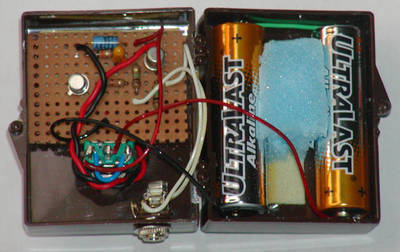
Rain Detector
"This rain detector will give you a heads-up the instant it starts to rain, hopefully giving you time to close windows and bring in possessions. The battery-powered circuit draws virtually no current when the sensor is dry and the current consumption is low when the buzzer is activated so a couple of AA cells will last a long time. Alternately, a molded power supply with a simple voltage regulator to drop the voltage to 3 volts could be used. The circuit is basically a handy flasher circuit that operates well on only 3 volts using ordinary silicon transistors. When the circuit is triggered, the buzzer is pulsed about once per second for a very short time, giving it a "dripping water" sound which seems appropriate. A slower, longer beep may be had by increasing the 1 uF capacitor. The 10 k resistor may be increased for a longer beep time without decreasing the beep rate but at some point the circuit will cease to function properly, depending on the gain of the transistors." [...]
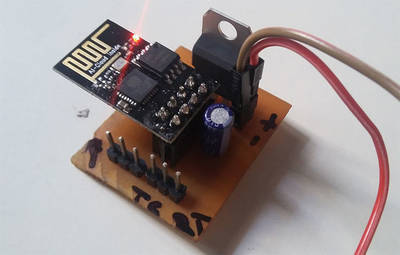
Plug and Play Board for IOT Module ESP8266-01
"Recently i have started with this super popular IOT development module. ESP8266-01. This module is really cool with its miniature size and low power consumption, but there is one really annoying thing about this. When you attempt to prototype something using this, it will give a hard time to you since it is not bread board compatible. Besides when you are prototyping with this you have to deal with many wires popping outta this module and keeping this fixed is really hard. In order to overcome this short comings i have made a simple homemade plug and play board for this module, which did a great job in resolving these shortcomings." [...]

Ultimate Electronics Helper || Variable Bench Top PSU With Helping Hands
"When working with electronics two tools are pretty much always needed. Today we'll be creating these two essentials. And we'll also take it one step further and merge these two together into the ultimate electronics helper! I'm of course talking about a Variable Bench Top PSU and a good pair of Helping hands! The PSU features variable voltage and current so it can be used in any number of projects. It also has a constant 5V output from a USB connector. As you've probably experienced a lot of DIY electronics projects require 5V and some other voltage. Helping hands always need a sturdy base to keep everything still. This is solved by mounting them onto a power supply unit, which usually weighs a lot. Let's get started!" [...]
NeoPixel Thermometer!
"My project is very simple and easy to accomplish. I chose this project to monitor the temperature of my room because having a guinea pig I should know the temperature because too low or too high could die U_U. My NeoPixel has 12 LEDs, the base temperature is 11 ° C and the maximum is 30 ° C, each LED has a temperature range of 1.5 (ie the first LED will light if it is at a temperature Between 11 and 12.5 degrees). To understand the temperature I printed on a sheet of temperature and then after bending I put it in the NeoPixel." [...]

LED CUBE 3x3x3
"hello guys this is a LED cube matrix of size 3x3x3 which contains 27 eld in total,,,designing such things which is entirely hardwired based you need to check for the amount of +VCc supply be needed by you so that i have used arduno uno (it has 12 vcc pins) as it matchec perfectly for my requiremnent." [...]
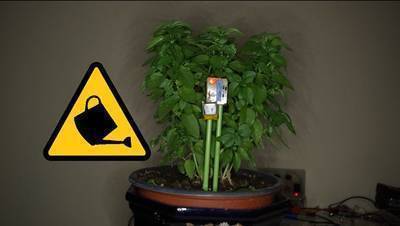
Plant Watering Warning
"a super simple circuit for plants" [...]

Temperature and Solar Sensor Using Arduinos
"These temperature and solar sensors are specifically designed to be used in the classroom. They are built using Arduinos, dallas temperature sensors, and homemade solar sensors produced by the QESST program at ASU." [...]
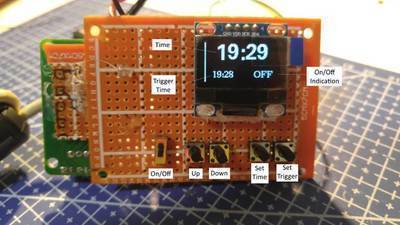
Arduino Timer and Triggers - Automated Shutters
"We live in a hot area where it can get quite unpleasant even at night, so we often leave the shutters open during the night and close them early in the morning when the sun comes out. I wanted to automate the closing of the shutters without connecting to the 220V electricity system so I devised an apparatus that would mechanically close the shutters by pressing on the electricity switches. The smarts behind this solution is an Arduino device that acts like an alarm clock but instead of sounding an alarm, closes the shutters :) The code behind the solution is generic and can be used as a trigger to any other operations / events you might want to perform. It is basically a digital clock where you set the trigger time (alarm) and an event is fired on that time. In this instructable I will not describe the mechanical apparatus that turns off the shutters and focus on the Arduino circuit and code since it is general purpose and can be reused in other projects as well." [...]

IoT Globe
"Here is a great weekend project to undertake, if you have one of plasma globes or a transparent spherical object which you can add LEDs to. And this is something, which you can use every morning before you head out to work/school. The IoT Globe use a Raspberry Pi zero, LEDs strip which is added with cotton inside the globe, and a speaker to read out weather condition, time to work and tweets for a specific hashtag. Here are the features implemented,as you see in video demo above. Weather condition for you city/town are shown with the help of LED diffusion inside the globe. That is, the globe will glow yellow for sunny day and blue if it is raining outside, so you know if you have to carry an umbrella before heading out. This feature uses the openweathermap.org API to get the weather condition, temperature and humidity and this will also be readout using the speaker connected to the Raspberry Pi. As part of the second feature, the globe glows Red,Orange,Green depending upon traffic/my time to work using the Google maps distance matrix API. Basically it takes me 25 to 30 minutes to get to work with no traffic, so if time to work is less than 30 mins then globe will glow green. The third feature is for you twitter fans out there, which get the latest tweets for a specific hashtag and reads them out via the speaker. These are the feature I have managed to implement, but you can make this your own by following the steps below and modifying the code. Post in the comments below, on what feature you plan to add.." [...]

RGB LED Pen for Lightpainting
"This is a complete build instruction for a light painting tool that uses an RGB LED controller. I use this controller a lot in my advanced tools and thought a documentary of how this is built and programmed can help some people. This tool is a modular RGB light pen meant for light writing, light drawing and lighting graffiti. It is easy to use because you only have the pen in your hand and you can quickly change the colour." [...]

ESP8266: Super compact WiFi Snipper for DeAuth attack
"Hello world! Few years ago, a new chip came to the market which started a new revolution! Yes, i am talking about the ESP8266. This chip is way more powerful in terms of CPU architecture, clock frequency, flash size and power consumption if we compare it with existing arduino boards that usually contains Atmel's AVR controllers. Actually i bought this ESP-01 modules few years back which was originally flashed with good old serial AT command firmware. Over the time, I figured out that the same chip can be directly programmed through the Arduino IDE. This feature is so amazing that you can practically use all existing arduino libraries and the same IDE to program the ESP8266 according to your need by flashing your own arduino sketch. (Word of caution: It will remove your existing AT commands firmware from the chip). After experimenting a lot with typical IoT stuff like thingspeak API or Blynk platform, I stopped working with ESP8266 for few months. During this period, I learned about stuff related to penetration testing of Wi-Fi. If you want to know more about cracking WPA handshakes click here to know more because its certainly out of the scope of this post. I thought, it would be great to build a device which is able to deauth all nearby WiFi devices instead of running deauth attack from terminal by entering bunch of commands. Thus, once again, i decided to pull out my ESP8266 module from the drawer after long time!" [...]

Poppy Ergo Jr
"Ergo Jr is a low cost arm designed for education, easy to build and modify. Thanks to visual programming, it can be used in schools to realize from small to more complex projects. Originally designed in the "Mathematics: a beautiful elsewhere" artistic experiment, the Ergo Jr has been adapted to fit with education needs. It is a robotic arm, consisting of 6 motors allowing life-like movements and 3D printed elements. The use of rivets make the assembly, modification and reassembly easy. Ergo Jr comes with three tools for different interactions with its environment: a lampshade, a gripper and a pen holder. The robot is controlled with a Raspberry Pi board, and a camera helps it interact with the world. Everything in the robot is let transparent and accessible to promote an educative approach and an interactive technology. Poppy Ergo Jr is an open-source robotic arm based on modular 3D printed conception and low-cost XL-320 motors. Poppy Ergo Jr robot is a small and low cost 6-degree-of-freedom robot arm. It consists of very simple shapes which can be easily 3D printed with FDM printers. It works with Dynamixel XL-320 motors, and a Raspberry Pi for control." [...]
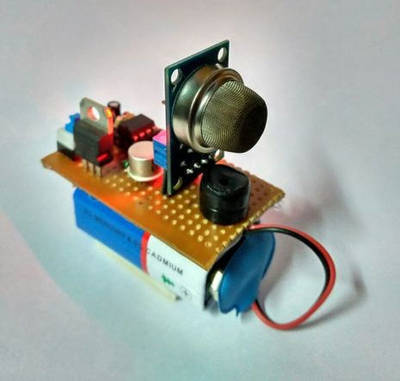
Gas Sensor Module
"We all know that most of the embedded systems are sensor and actuators connected and operated based on those values of sensors. So we need to calibrate the sensors such than they must produce the required output for embedded systems to take action. So here we have one design, "GAS Sensor Module For Embedded System Design", This is a beginner project which take few hours to do it. But so tricky to do at first time. Let me explain you how i did it, Here few steps to follow...! So lets begin...!" [...]
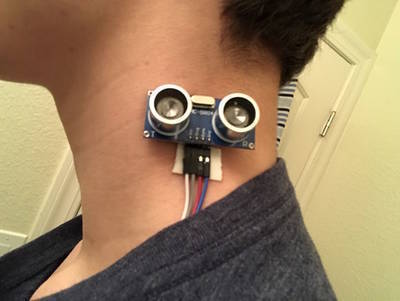
Arduino Assistive Technology for the Visually Impaired
"This contraption uses servos and buzzers that react to the read distance returned by 2 ultrasonic distance sensors. So if you're blind and somehow you managed to read this and thought the pictures were cool the next thing that you have to do is put the really small parts together without being able to see them, easy right, after that you will no longer be breaking your nose and stubbing your toes on things so yeah totally worth it. On both shoulders you will have an ultrasonic distance sensor that returns the distance which a servo (on the same shoulder) that presses a specific amount (depending on the distance), and when the item (thing that the distance sensor is seeing) comes too close a buzzer, on the same shoulder, beeps quietly just to emphasise that there is an object right next to your shoulder." [...]

Intelligent Level Sensor Network
"The project proposes a wireless-level sensor network for the enhancement of essential urban services. By means of an ultrasonic sensor it is possible to determine the distance of an object/obstacle from the sensor. In this way the level of liquids or solids can be determined with the same sensor. Immediate applications are listed below: Monitoring of water level in homes and buildings. In Brazil, there are regions where water supply is scarce (eg, northeast) and other regions with sporadic water crises (eg São Paulo 2014-2015). By knowing the level of the water reservoirs in a significant number of buildings it is possible to direct water to the most critical places, that is, to make an intelligent water management. In addition, the system can provide data to regulatory agencies and allow monitoring of the quality of the service, since the information disclosed by the sanitation companies does not always match what is reported by the population; Level monitoring of water in rain and river galleries (urban drainage). Several Brazilian cities suffer from flooding points, which causes great damage to the government and individuals. Through the continuous monitoring of the water level of rivers and storm drainage systems, it is possible to identify flood risk, clogging points and bottleneck points in drainage. This makes possible the intelligent management of the urban drainage and management system; Level monitoring of garbage in dumps or litter bins arranged in city streets. The collection of urban waste is an essential service for the control of diseases, for the well being of the population and for environmental management. Moving a collection team to empty dumps creates unnecessary cost; on the other hand, leaving a dump with waste for a long time causes problems due to the deterioration of the present materials. By knowing the filling state of the dumps, dump buckets and collection points, the person responsible for the collection can trace an efficient route and also ensure that the collection time is fulfilled. Efficient routes mean less spending on fuel, staff and fleet reduction." [...]
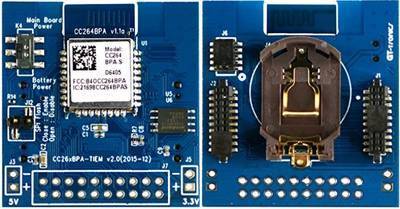
“Everything is Better with Bluetooth”: Add Your Own Custom Bluetooth LE to Your Next Project
"This article uses Code Composer Studio to program a pre-certified module with TI's CC2640F128 Bluetooth System on Chip to function as a simple UART transmitter. This project provides the basis to inexpensively add BluetoothLE to any of your projects. Bluetooth Low Energy (BLE) was designed for the Internet of Things. This project will provide the steps needed to add BLE to your next project at the module level. By programming a precertified module yourself, you can add Bluetooth to your next project for $5 per module ($25 for 5 modules), or $3.80 when purchasing a batch of 1000. This is a 75% reduction in cost over most hobbyist modules available through Sparkfun or Adafruit. This project uses a JTAG programmer that is available for $15 from Texas Instruments. That means that you are able to program your first five modules for $40, with additional batches of five modules for $25." [...]

Arduino MIDI Fighter
"Now this is a story all about how my life got flipped, turned- whoops, so sorry; wrong story. This is actually a story about a project I've been dreaming of working on since I first learned about Arduino and open source: a MIDI controller inspired by the MIDI Fighter by DJ Tech Tools, complete with light-up arcade buttons. It took a while for my skills to catch up to my project aspirations though, so finally, a few years later, I've built my version of a DIY MIDI Fighter. Now obviously this isn't an original concept to make. You can find quite a few different ones by different makers all over the internet, but what I think is awesome about this project is that no single MIDI Fighter is the same, whether it be hardware hook-up, final housing or code iteration. Even the microcontrollers vary. So with all of that, here is my humble version. I hope that my work helps you with your own open source MIDI explorations." [...]
Pixel Art Frame
"I’ve always wanted to play with a big LED matrix, and now I have! 🙂 In this post, I’m making a Pixel Art frame, capable of displaying images, scrolling text, etc … Useful to show the weather, social media notifications, and whatever else you can think of!" [...]

Tipo : Braille Smartphone Keypad
"After working with the user group on earlier version's of braille keyboards, it was highlighted that there is no comprehensive way of typing into a smartphone. Current software solutions are too slow, do not give good tactile feedback or just are a pain to type with. Even though there are many soft keyboards available, we couldn't find someone in our study group who uses any of the soft keyboards. In our study conducted, out of 10 people, 7 use "Feature Phones", and the rest had smartphones but would take the help of a colleague or family member to type. It was the tactile buttons and not the cost that caused them to use feature phones. Thus it was concluded that it is necessary to have a tactile keyboard in order for more visually impaired to use a smartphone. The other challenge is faced by those who have recently lost their sight, and do not know how to use braille. A fast and efficient way in which this group of people can learn braille, is important" [...]

Solr: digital wrist watch
"15 months ago. This is when I started working on this project. The Solr digital wrist watch is a clock that won’t work without a battery but it will neither work without sun. Even more: the vintage display is really cool but it’s hard to read outdoors. A complete nonsense. It is almost a joke and some might easily file it under the “useless projects” label. But it’s still quite useful. Whether you don’t care about accuracy, or if you need an excuse to always be late. Or maybe you want your daughter to raise her eyebrowns and tenderly call you a “freak”. Either case I suggest you to proudly wear a Solr." [...]

How to Build a Web-based Garage Door Controller
"I was motivated to find a new solution to controlling my garage door because I didn't want to carry an extra remote around, and they just don't work very well. This article demontrates how to use a CC3200 to connect to an existing garage door opener. The CC3200 acts as a TCP server which can send information about the garage door state to any network capable device. The garage door can also be opened and closed by sending a TCP message. An Android application is also created to act as a garage door remote." [...]
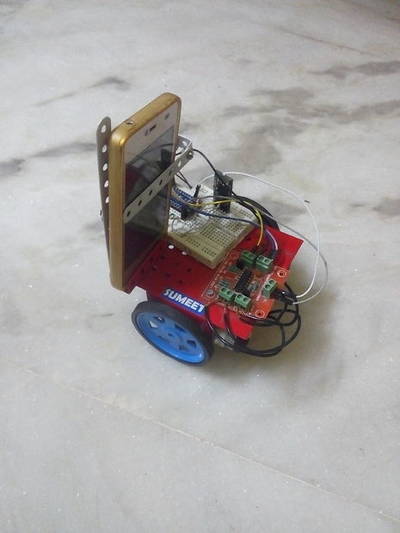
Bluetooth Controlled Car With Camera
"Played with wireless remote controlled cars right from childhood right??? Well even if you don't you will build it now.It's rather simple and not much complicated. Remote control is your smartphone itself and I have also included a camera feature so that user can see what's in front of the car!!! I developed this so that everyone can build their own car with a very few amount of money!!! Now you are very familiar with arduino now-a-days. using arduino as brains of the project is rather easy and simple. And for the wireless connectivity we would use the Bluetooth communication. So I have developed the tutorial with complete steps and pics. So let's get started..." [...]
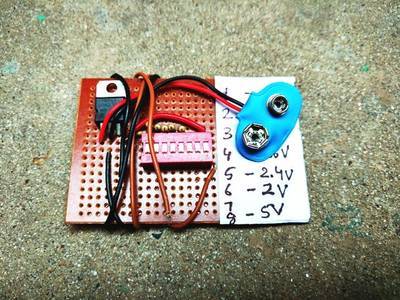
5V Battery Powered Pocket Sized Variable Power Supply
"The power supply presented here is Battery Powered, Variable and pocket Sized. It is portable and fully functional. You not have to now carry AA Sized Cells. I get frustrated when I need AA or AAA sized Batteries. At those times, this power supply is made for. It comes handy when you do not want a heavy duty power supply. This power Supply unit can be adjusted. You can adjust the output with the help of the DIP switches attached. I have used a sticker paper on a left out portion of PCB for showing output voltage information. The circuit is extremely simple. This can be beginner's first ever power supply unit. You must know Basics Of Electronics and about resistors as they are the main things." [...]
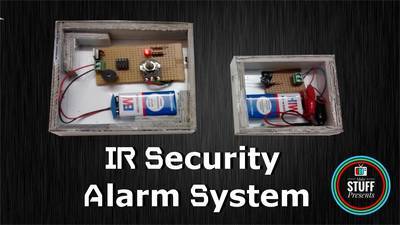
How to Make IR Security Alarm & a IR Detector Using LM358
"In this project i will show you how to make a IR Security Alarm and a IR Detector with the same circuit, just with little modification. For the indication we have included both Buzzer & LED." [...]
That's all Folks!


